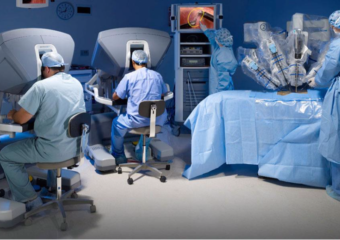High-Quality Best Laparoscopic Sleeve Gastrectomy In India
How Much Does Laparoscopic Sleeve Gastrectomy Cost in India?
Many potential patients for surgery are a concern to know about Laparoscopic sleeve gastrectomy cost In India? The estimated cost of Laparoscopic sleeve gastrectomy In India usually starts $4,800 however, it may go up to as much as $6,000. it depends on the hospital charges and the fee charged by the surgeon. This price usually does not cover the post-operational program. Additional costs also involve the diagnostics before the surgery and pre-operational consultations.

What is Laparoscopic Sleeve Gastrectomy?
In a Laparoscopic sleeve gastrectomy, also known as a vertical sleeve gastrectomy or gastric sleeve procedure, the outer margin of the stomach is removed to restrict food intake, leaving a sleeve of stomach, roughly the size and shape of a banana, and the pylorus, the muscle that controls emptying of food from the stomach into the intestine. A sleeve gastrectomy is a purely restrictive procedure.
The Laparoscopic sleeve gastrectomy, by reducing the size of the stomach, allows the patient to feel full after eating less and taking in fewer calories. The surgery removes that portion of the stomach that produces a hormone that can makes a patient feel hungry.
How Does it Work?
The effect of the sleeve gastrectomy is that you can eat a very small meal, feel full and satisfied and the hunger you would now feel from eating such a small meal does not occur.
By eating not more than a half cup of solid food your stomach will be full. You can’t eat any more! Food now sits at the top of the stomach. This activates nerves to the brain telling the brain the stomach is full and this causes the brain to turn off the hunger mechanism.
There is a second mechanism at work here although there remains some controversy over this. The main hunger hormone is known as ghrelin. The stomach that we resect secretes at least 60% of the body’s ghrelin. This may further reduce the hunger which would normally occur after eating very small meals.
Although the meals may be small, you can eat almost any food, just very small amounts. You will have no problem eating out.
Who should be fit for Laparoscopic sleeve gastrectomy surgery?
Laparoscopic sleeve gastrectomy is advised to person who have very high BMI (35 or above) or who are at risk for undergoing long duration procedures due to underlying heart or lung problem. Sleeve gastrectomy is also suggested for individuals who are over-weight and have BMI less than 30 along with medical conditions like;diabetes, hypertension and heart disease. Sleeve gastrectomy is often used as a part of staged approach to weight-loss in obese people and is followed by gastric by-pass surgery.
Advantages of Laparoscopic sleeve gastrectomy
- Patient are expected to lose 40-70% of their excess body weight in first year of surgery
- Less food intolerance than with the gastric band.
- No implantable band device
- Surgical risk is lower than with gastric bypass while weight loss is similar.
- Lower risk of injection
- Shorter Hospital stay
- Fast recovery
Disadvantages of Laparoscopic sleeve gastrectomy
- Sleeve gastrectomy is relatively new and has not been evaluated as much gastric banding or gastric bypass.
- Sleeve gastrectomy is irreversible.
- Complication risks are slightly higher than with Lap-band.
Before laparoscopic sleeve gastrectomy
- Patient to receive verbal and written information about the laparoscopic sleeve gastrectomy
- Consent form to be signed before admission
- Patient to attend pre assessment clinic
- Female patients taking the contraceptive pill or who have the contraceptive implant to stop or have removed 6 weeks before their operation date. Other forms of contraception to be advised. Can be re-started 6 weeks post-surgery.
- Female patients on HRT to stop 4-6 weeks before operation date Can be restarted 6 weeks post-surgery.
- Dalteparin take home pack given (burner bin)
- Two weeks before surgery all patients to start the liver reducing diet and visit their GP to get all medications changed to liquid/soluble or crushable forms.
- Medications in this form only appropriate for after surgery and patients advised to continue on solid dose form up to day of surgery.
- If the patients uses a CPAP/BiPAP machine, to be advised to bring this in on admission along with their mask and user manual
During Laparoscopic sleeve gastrectomy procedure
The laparoscopic sleeve gastrectomy done under general anesthesia, your surgeon will amke 4-5 small incision in your stomach that are used to pass surgical instruments, including a laparoscope camera. it will increase visibility, while the laparoscopic method involves less pain, scarring and recovery time.
During a laparoscopic sleeve gastrectomy, your surgeon will remove up to 80-90% of you left side of stomach, reducing its size and capacity to enhance weight loss. The stomach is vertically divided into two parts, creating a small pouch shaped like a banana or a sleeve. After stapling the stomach, the surgeon removes the excess. The laparoscopic sleeve gastrectomy is a restrictive operation, since it limits the food intake, but it does not alter the normal function of the digestive system.
Most of the weight loss surgeries can be performed either through laparoscopy or open surgery, but the latter involves a higher risk of infections and adhesions, since the internal scarring can cause additional complications.

What should I expect after surgery?
- You will be helped to walk around after surgery to help prevent blood clots.
- Medicines may be given to prevent or treat pain, nausea, or a bacterial infection.
- A nasogastric (NG) tube may be put into your nose and down into your stomach during surgery. The NG tube helps prevent vomiting and may help get your intestines working. The NG tube is usually removed 1 day after surgery.
- If you have a drain in your wound, it will be removed when it stops draining blood and fluid. You may have a catheter in your bladder to help drain urine. This is usually removed the day after surgery.
- A test called a contrast swallow may be done the first day after surgery. This test checks for leaks in your stomach. You will be able to have clear liquids once your stomach starts working after surgery and tests show no leaks. You may be given ice chips at first. Then you will get clear liquids such as water, broth, or juice.
After Laparoscopic sleeve gastrectomy
- After the surgery, you will have to follow a very restricted diet. Usually non-carbonated and sugar-free liquids are recommended immediately after surgery.
- You will have to restrict your diet to pureed food items for at least three weeks.
- Regular foods are normally allowed 3 to 4 weeks after the surgery.
- As the reaction to rapid weight loss, the patient may experience changes such as tiredness, body pain, dry skin, hair loss, and mood swings during the first few months after the surgery.
- Vitamin tablets and calcium supplements should be taken as per the prescription.
- Most importantly, you will have to follow the lifestyle changes recommended by your doctor.
- In case if you don’t follow them, there are chances that you regain the weight you lost, and hence the surgery becomes unsuccessful. To avoid this, you will have to bring permanent and healthy diet modifications along with regular exercise routine.
- If you feel that you are not getting desired results after the surgery or have any serious health issues, immediately inform your doctor for further evaluations and medication.
Risks of laparoscopic sleeve gastrectomy surgery
Any surgery done under general anesthesia carries some risk for heart and brain damage, but these risks are low. laparoscopic sleeve gastrectomy is a shorter procedure than other types of gastric bypass surgery. With laparoscopic sleeve gastrectomy surgery you have a 5% to 10% risk for a complication such as:
- Leaking of stomach juices from where the stomach has been removed
- Bleeding
- Blood clot that forms in your leg and travels to your lungs and heart
- Narrowing of the inside diameter of the new stomach
- Deep venous thrombosis (DVT)
- Pulmonary embolism
- Infection
- Hernia
- Nutrients poorly absorbed
To help protect against GI problems and weight regain, you should continue to have careful follow-up past the third year after surgery.
Recovery laparoscopic sleeve gastrectomy
Patients who undergo a laparoscopic sleeve gastrectomy typically spend one or two nights in the hospital after the procedure. Depending on their condition and medical history, most people can return to work within two to three weeks.
Diet after laparoscopic sleeve gastrectomy
1st Week After Surgery
During your first week after laparoscopic sleeve gastrectomy procedure, you will be continue to clear liquids. it will help to avoid postoperative complications, you can drink clear broth, decaffeinated beverages, and the sugar-free versions of drink mixes like Kool-Aid and Crystal Light. Forgo carbonated beverages, caffeine, and anything with added sugar.
2nd Week After Surgery
In second week of post-op you can add thicker liquids diet. These may include such items as applesauce, cream of wheat, Greek yogurt, protein shakes, and sugar-free ice creams and puddings.
3rd Week After Surgery
In third week of post-op, you can add Soft and pureed foods come next. Examples include eggs, ground meats, fish, beans, cooked vegetables, and soft fruits. Other possibilities include hummus and cottage cheese.
4th Week After Surgery
Now that you’re one month post-surgery Solid foods are finally back in your routine. At this point, the post-op diet is similar to your presurgical diet. Certain items remain off limits: fried foods, candy, nuts, seeds, whole dairy products, breads, pastas, and fibrous vegetables such as broccoli. You are allowed to reintroduce caffeine, but only in small quantities.










